Priorities to Improve Public Health: Reducing Smoking in Lambeth
VerifiedAdded on 2023/06/12
|16
|4680
|137
AI Summary
This paper discusses the seven priorities established by the Public Health England to combat health challenges in England, with a focus on reducing smoking in Lambeth. It highlights the variables that determine health for reducing smoking, the impact of inequality on health, challenges facing reducing smoking in the UK and Lambeth, and the role of inter-professionals in Lambeth to reduce smoking.
Contribute Materials
Your contribution can guide someone’s learning journey. Share your
documents today.

Nursing 1
NURSING
By (Student’s Name)
Professor’s Name
College
Course
Date
NURSING
By (Student’s Name)
Professor’s Name
College
Course
Date
Secure Best Marks with AI Grader
Need help grading? Try our AI Grader for instant feedback on your assignments.
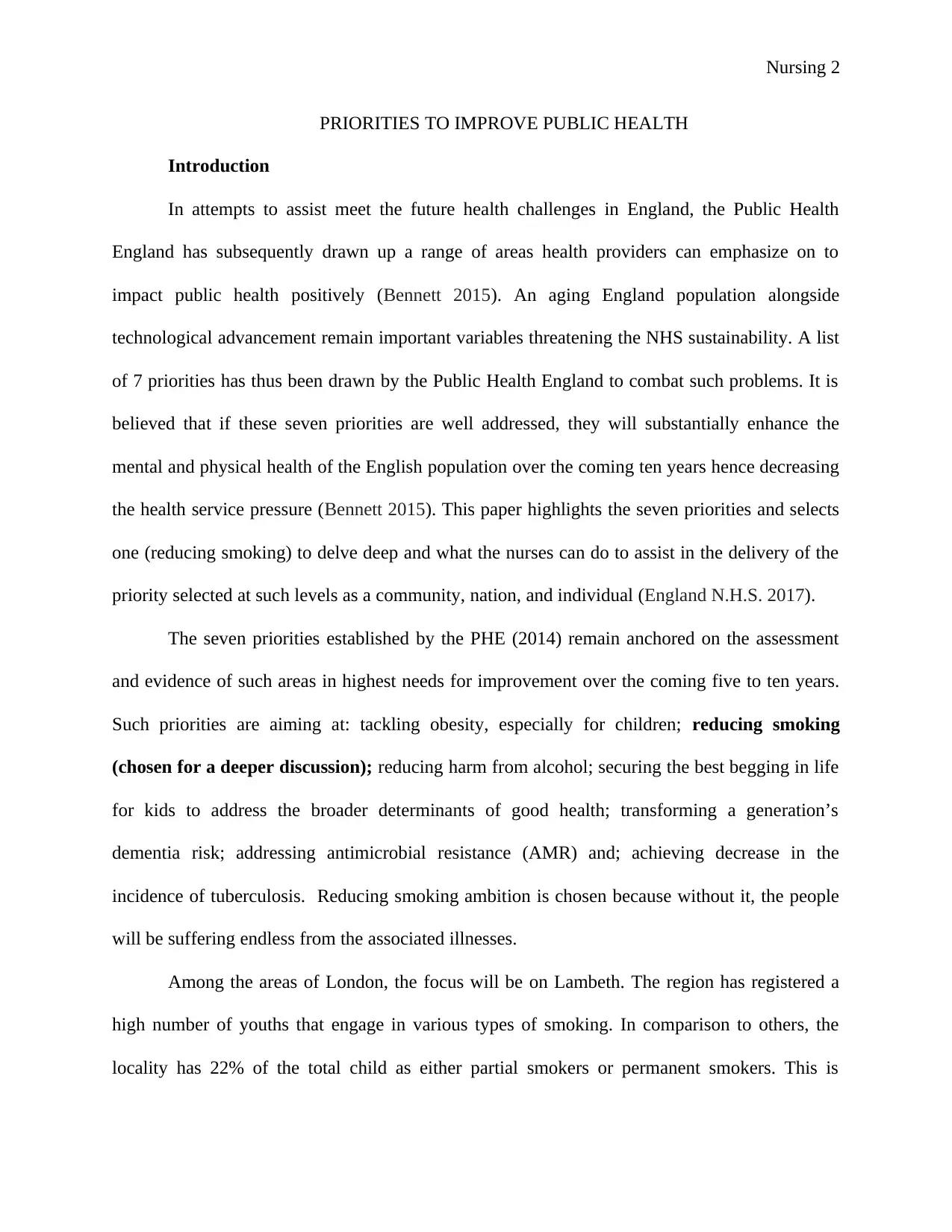
Nursing 2
PRIORITIES TO IMPROVE PUBLIC HEALTH
Introduction
In attempts to assist meet the future health challenges in England, the Public Health
England has subsequently drawn up a range of areas health providers can emphasize on to
impact public health positively (Bennett 2015). An aging England population alongside
technological advancement remain important variables threatening the NHS sustainability. A list
of 7 priorities has thus been drawn by the Public Health England to combat such problems. It is
believed that if these seven priorities are well addressed, they will substantially enhance the
mental and physical health of the English population over the coming ten years hence decreasing
the health service pressure (Bennett 2015). This paper highlights the seven priorities and selects
one (reducing smoking) to delve deep and what the nurses can do to assist in the delivery of the
priority selected at such levels as a community, nation, and individual (England N.H.S. 2017).
The seven priorities established by the PHE (2014) remain anchored on the assessment
and evidence of such areas in highest needs for improvement over the coming five to ten years.
Such priorities are aiming at: tackling obesity, especially for children; reducing smoking
(chosen for a deeper discussion); reducing harm from alcohol; securing the best begging in life
for kids to address the broader determinants of good health; transforming a generation’s
dementia risk; addressing antimicrobial resistance (AMR) and; achieving decrease in the
incidence of tuberculosis. Reducing smoking ambition is chosen because without it, the people
will be suffering endless from the associated illnesses.
Among the areas of London, the focus will be on Lambeth. The region has registered a
high number of youths that engage in various types of smoking. In comparison to others, the
locality has 22% of the total child as either partial smokers or permanent smokers. This is
PRIORITIES TO IMPROVE PUBLIC HEALTH
Introduction
In attempts to assist meet the future health challenges in England, the Public Health
England has subsequently drawn up a range of areas health providers can emphasize on to
impact public health positively (Bennett 2015). An aging England population alongside
technological advancement remain important variables threatening the NHS sustainability. A list
of 7 priorities has thus been drawn by the Public Health England to combat such problems. It is
believed that if these seven priorities are well addressed, they will substantially enhance the
mental and physical health of the English population over the coming ten years hence decreasing
the health service pressure (Bennett 2015). This paper highlights the seven priorities and selects
one (reducing smoking) to delve deep and what the nurses can do to assist in the delivery of the
priority selected at such levels as a community, nation, and individual (England N.H.S. 2017).
The seven priorities established by the PHE (2014) remain anchored on the assessment
and evidence of such areas in highest needs for improvement over the coming five to ten years.
Such priorities are aiming at: tackling obesity, especially for children; reducing smoking
(chosen for a deeper discussion); reducing harm from alcohol; securing the best begging in life
for kids to address the broader determinants of good health; transforming a generation’s
dementia risk; addressing antimicrobial resistance (AMR) and; achieving decrease in the
incidence of tuberculosis. Reducing smoking ambition is chosen because without it, the people
will be suffering endless from the associated illnesses.
Among the areas of London, the focus will be on Lambeth. The region has registered a
high number of youths that engage in various types of smoking. In comparison to others, the
locality has 22% of the total child as either partial smokers or permanent smokers. This is

Nursing 3
according to research carried out by Dr. Richard Kenton. The region has also registered a lot of
patients in the local hospitals who are affected directly by diseases caused by excessive smoking.
This, therefore, helps to understand why the essay focuses on the locality even more (Quinn and
Morris 2017). Finance; the locality being affected is very massive. The people affected are also a
considerable population. These, therefore, require a lot of funds in rolling out the program. The
groups, therefore, do not receive the funding that can help control smoking. The locality is also
made up of people living within low standards. They, therefore, expect that, while rehabilitating
them, their living standards are improved (Illingworth and Chelvanayagam 2017). The UK state
government can only make the improvements. Therefore funding becomes a significant
challenge in implementing the ambition. The public health program should also organize mass
education program. The program should focus on men being the group that is affected most.
These will see the men change their lifestyle.
Issues of London Locality:
Variables that determine health for smoking
The primary variables that determine health for reducing smoking include;
Social support. The friends and associates of a person influence their decision. It is difficult to
minimize smoking if everyone around the society will live in, does smoke. In Lambeth society,
the young seem to be copying the adults. The influence, therefore, makes many young people
begin smoking (Axfor et al. 2018). The culture presents smoking as a “cool’ thing to do. The
young people, therefore, smoke to fit into the culture (Bennett 2015).
Education. Most of the young people do not know the effects of smoking. They,
therefore, need to be taught on the impact of smoking on their health and their lives. When they
according to research carried out by Dr. Richard Kenton. The region has also registered a lot of
patients in the local hospitals who are affected directly by diseases caused by excessive smoking.
This, therefore, helps to understand why the essay focuses on the locality even more (Quinn and
Morris 2017). Finance; the locality being affected is very massive. The people affected are also a
considerable population. These, therefore, require a lot of funds in rolling out the program. The
groups, therefore, do not receive the funding that can help control smoking. The locality is also
made up of people living within low standards. They, therefore, expect that, while rehabilitating
them, their living standards are improved (Illingworth and Chelvanayagam 2017). The UK state
government can only make the improvements. Therefore funding becomes a significant
challenge in implementing the ambition. The public health program should also organize mass
education program. The program should focus on men being the group that is affected most.
These will see the men change their lifestyle.
Issues of London Locality:
Variables that determine health for smoking
The primary variables that determine health for reducing smoking include;
Social support. The friends and associates of a person influence their decision. It is difficult to
minimize smoking if everyone around the society will live in, does smoke. In Lambeth society,
the young seem to be copying the adults. The influence, therefore, makes many young people
begin smoking (Axfor et al. 2018). The culture presents smoking as a “cool’ thing to do. The
young people, therefore, smoke to fit into the culture (Bennett 2015).
Education. Most of the young people do not know the effects of smoking. They,
therefore, need to be taught on the impact of smoking on their health and their lives. When they
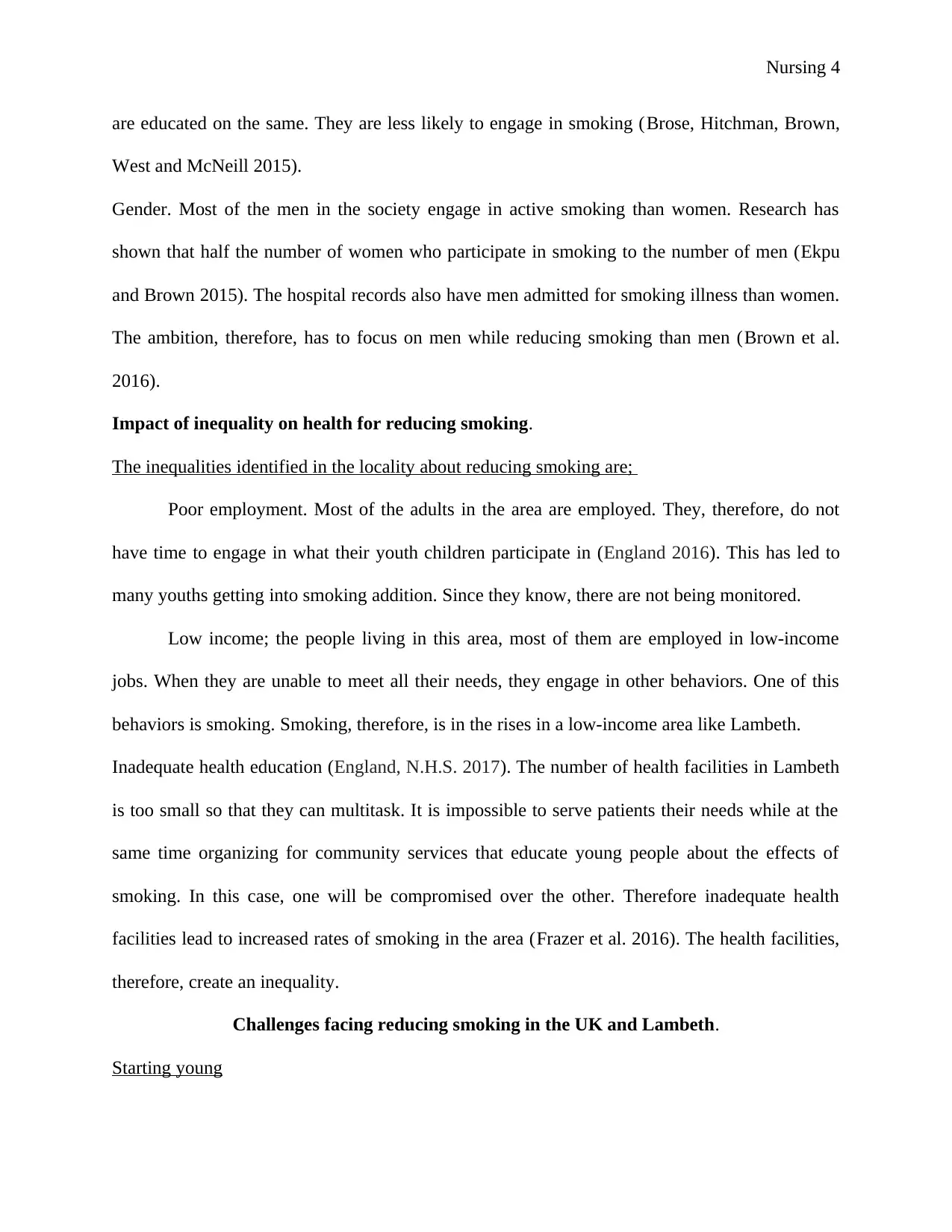
Nursing 4
are educated on the same. They are less likely to engage in smoking (Brose, Hitchman, Brown,
West and McNeill 2015).
Gender. Most of the men in the society engage in active smoking than women. Research has
shown that half the number of women who participate in smoking to the number of men (Ekpu
and Brown 2015). The hospital records also have men admitted for smoking illness than women.
The ambition, therefore, has to focus on men while reducing smoking than men (Brown et al.
2016).
Impact of inequality on health for reducing smoking.
The inequalities identified in the locality about reducing smoking are;
Poor employment. Most of the adults in the area are employed. They, therefore, do not
have time to engage in what their youth children participate in (England 2016). This has led to
many youths getting into smoking addition. Since they know, there are not being monitored.
Low income; the people living in this area, most of them are employed in low-income
jobs. When they are unable to meet all their needs, they engage in other behaviors. One of this
behaviors is smoking. Smoking, therefore, is in the rises in a low-income area like Lambeth.
Inadequate health education (England, N.H.S. 2017). The number of health facilities in Lambeth
is too small so that they can multitask. It is impossible to serve patients their needs while at the
same time organizing for community services that educate young people about the effects of
smoking. In this case, one will be compromised over the other. Therefore inadequate health
facilities lead to increased rates of smoking in the area (Frazer et al. 2016). The health facilities,
therefore, create an inequality.
Challenges facing reducing smoking in the UK and Lambeth.
Starting young
are educated on the same. They are less likely to engage in smoking (Brose, Hitchman, Brown,
West and McNeill 2015).
Gender. Most of the men in the society engage in active smoking than women. Research has
shown that half the number of women who participate in smoking to the number of men (Ekpu
and Brown 2015). The hospital records also have men admitted for smoking illness than women.
The ambition, therefore, has to focus on men while reducing smoking than men (Brown et al.
2016).
Impact of inequality on health for reducing smoking.
The inequalities identified in the locality about reducing smoking are;
Poor employment. Most of the adults in the area are employed. They, therefore, do not
have time to engage in what their youth children participate in (England 2016). This has led to
many youths getting into smoking addition. Since they know, there are not being monitored.
Low income; the people living in this area, most of them are employed in low-income
jobs. When they are unable to meet all their needs, they engage in other behaviors. One of this
behaviors is smoking. Smoking, therefore, is in the rises in a low-income area like Lambeth.
Inadequate health education (England, N.H.S. 2017). The number of health facilities in Lambeth
is too small so that they can multitask. It is impossible to serve patients their needs while at the
same time organizing for community services that educate young people about the effects of
smoking. In this case, one will be compromised over the other. Therefore inadequate health
facilities lead to increased rates of smoking in the area (Frazer et al. 2016). The health facilities,
therefore, create an inequality.
Challenges facing reducing smoking in the UK and Lambeth.
Starting young
Secure Best Marks with AI Grader
Need help grading? Try our AI Grader for instant feedback on your assignments.
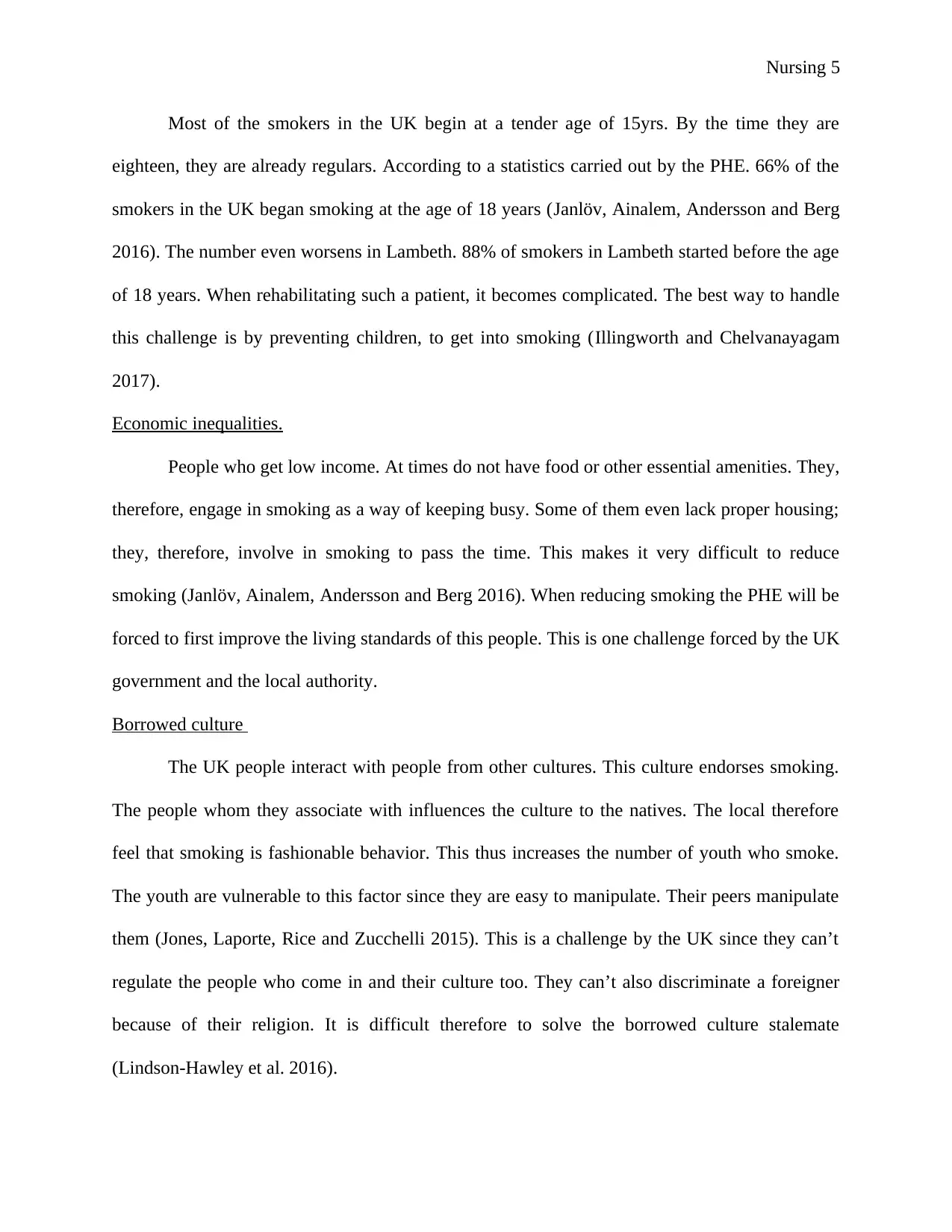
Nursing 5
Most of the smokers in the UK begin at a tender age of 15yrs. By the time they are
eighteen, they are already regulars. According to a statistics carried out by the PHE. 66% of the
smokers in the UK began smoking at the age of 18 years (Janlöv, Ainalem, Andersson and Berg
2016). The number even worsens in Lambeth. 88% of smokers in Lambeth started before the age
of 18 years. When rehabilitating such a patient, it becomes complicated. The best way to handle
this challenge is by preventing children, to get into smoking (Illingworth and Chelvanayagam
2017).
Economic inequalities.
People who get low income. At times do not have food or other essential amenities. They,
therefore, engage in smoking as a way of keeping busy. Some of them even lack proper housing;
they, therefore, involve in smoking to pass the time. This makes it very difficult to reduce
smoking (Janlöv, Ainalem, Andersson and Berg 2016). When reducing smoking the PHE will be
forced to first improve the living standards of this people. This is one challenge forced by the UK
government and the local authority.
Borrowed culture
The UK people interact with people from other cultures. This culture endorses smoking.
The people whom they associate with influences the culture to the natives. The local therefore
feel that smoking is fashionable behavior. This thus increases the number of youth who smoke.
The youth are vulnerable to this factor since they are easy to manipulate. Their peers manipulate
them (Jones, Laporte, Rice and Zucchelli 2015). This is a challenge by the UK since they can’t
regulate the people who come in and their culture too. They can’t also discriminate a foreigner
because of their religion. It is difficult therefore to solve the borrowed culture stalemate
(Lindson-Hawley et al. 2016).
Most of the smokers in the UK begin at a tender age of 15yrs. By the time they are
eighteen, they are already regulars. According to a statistics carried out by the PHE. 66% of the
smokers in the UK began smoking at the age of 18 years (Janlöv, Ainalem, Andersson and Berg
2016). The number even worsens in Lambeth. 88% of smokers in Lambeth started before the age
of 18 years. When rehabilitating such a patient, it becomes complicated. The best way to handle
this challenge is by preventing children, to get into smoking (Illingworth and Chelvanayagam
2017).
Economic inequalities.
People who get low income. At times do not have food or other essential amenities. They,
therefore, engage in smoking as a way of keeping busy. Some of them even lack proper housing;
they, therefore, involve in smoking to pass the time. This makes it very difficult to reduce
smoking (Janlöv, Ainalem, Andersson and Berg 2016). When reducing smoking the PHE will be
forced to first improve the living standards of this people. This is one challenge forced by the UK
government and the local authority.
Borrowed culture
The UK people interact with people from other cultures. This culture endorses smoking.
The people whom they associate with influences the culture to the natives. The local therefore
feel that smoking is fashionable behavior. This thus increases the number of youth who smoke.
The youth are vulnerable to this factor since they are easy to manipulate. Their peers manipulate
them (Jones, Laporte, Rice and Zucchelli 2015). This is a challenge by the UK since they can’t
regulate the people who come in and their culture too. They can’t also discriminate a foreigner
because of their religion. It is difficult therefore to solve the borrowed culture stalemate
(Lindson-Hawley et al. 2016).
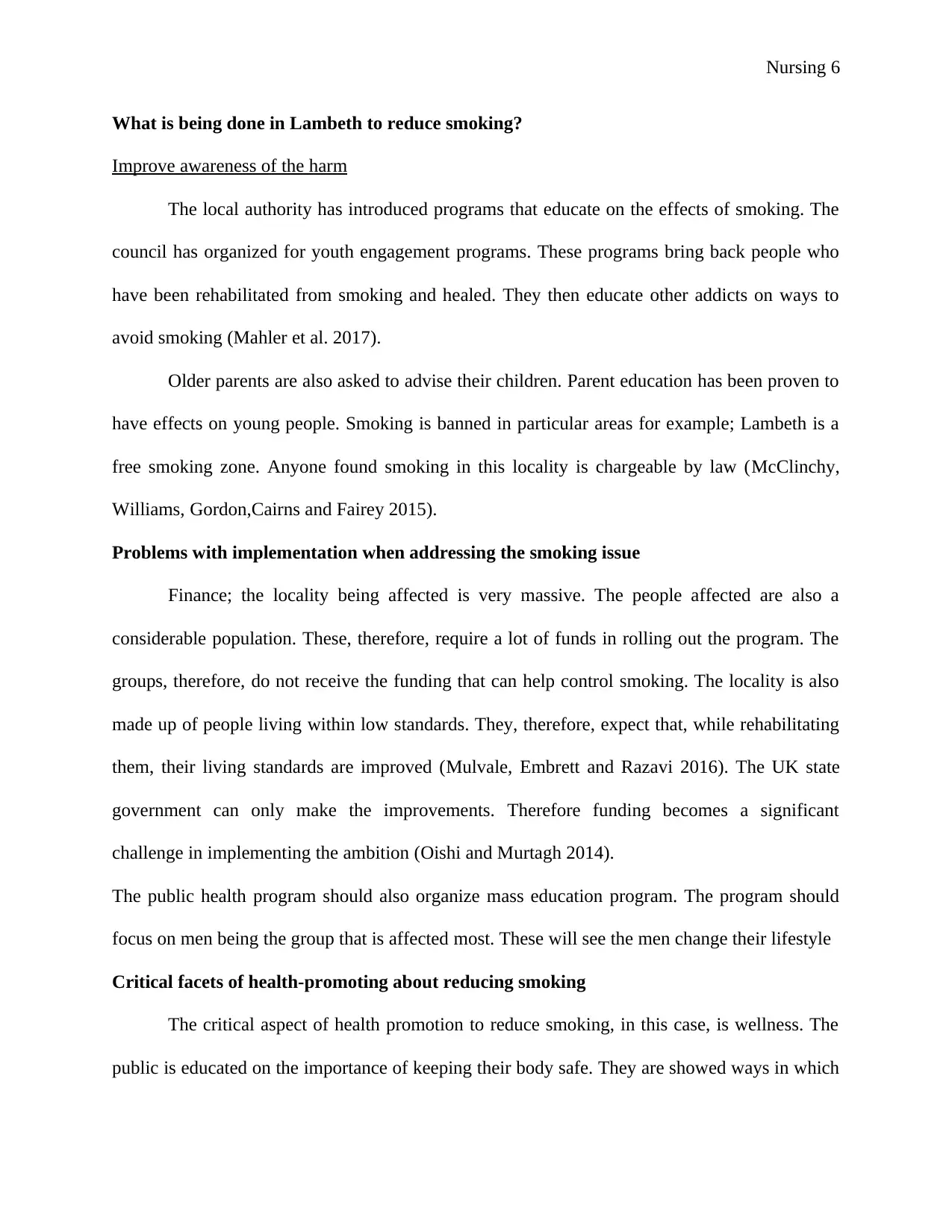
Nursing 6
What is being done in Lambeth to reduce smoking?
Improve awareness of the harm
The local authority has introduced programs that educate on the effects of smoking. The
council has organized for youth engagement programs. These programs bring back people who
have been rehabilitated from smoking and healed. They then educate other addicts on ways to
avoid smoking (Mahler et al. 2017).
Older parents are also asked to advise their children. Parent education has been proven to
have effects on young people. Smoking is banned in particular areas for example; Lambeth is a
free smoking zone. Anyone found smoking in this locality is chargeable by law (McClinchy,
Williams, Gordon,Cairns and Fairey 2015).
Problems with implementation when addressing the smoking issue
Finance; the locality being affected is very massive. The people affected are also a
considerable population. These, therefore, require a lot of funds in rolling out the program. The
groups, therefore, do not receive the funding that can help control smoking. The locality is also
made up of people living within low standards. They, therefore, expect that, while rehabilitating
them, their living standards are improved (Mulvale, Embrett and Razavi 2016). The UK state
government can only make the improvements. Therefore funding becomes a significant
challenge in implementing the ambition (Oishi and Murtagh 2014).
The public health program should also organize mass education program. The program should
focus on men being the group that is affected most. These will see the men change their lifestyle
Critical facets of health-promoting about reducing smoking
The critical aspect of health promotion to reduce smoking, in this case, is wellness. The
public is educated on the importance of keeping their body safe. They are showed ways in which
What is being done in Lambeth to reduce smoking?
Improve awareness of the harm
The local authority has introduced programs that educate on the effects of smoking. The
council has organized for youth engagement programs. These programs bring back people who
have been rehabilitated from smoking and healed. They then educate other addicts on ways to
avoid smoking (Mahler et al. 2017).
Older parents are also asked to advise their children. Parent education has been proven to
have effects on young people. Smoking is banned in particular areas for example; Lambeth is a
free smoking zone. Anyone found smoking in this locality is chargeable by law (McClinchy,
Williams, Gordon,Cairns and Fairey 2015).
Problems with implementation when addressing the smoking issue
Finance; the locality being affected is very massive. The people affected are also a
considerable population. These, therefore, require a lot of funds in rolling out the program. The
groups, therefore, do not receive the funding that can help control smoking. The locality is also
made up of people living within low standards. They, therefore, expect that, while rehabilitating
them, their living standards are improved (Mulvale, Embrett and Razavi 2016). The UK state
government can only make the improvements. Therefore funding becomes a significant
challenge in implementing the ambition (Oishi and Murtagh 2014).
The public health program should also organize mass education program. The program should
focus on men being the group that is affected most. These will see the men change their lifestyle
Critical facets of health-promoting about reducing smoking
The critical aspect of health promotion to reduce smoking, in this case, is wellness. The
public is educated on the importance of keeping their body safe. They are showed ways in which
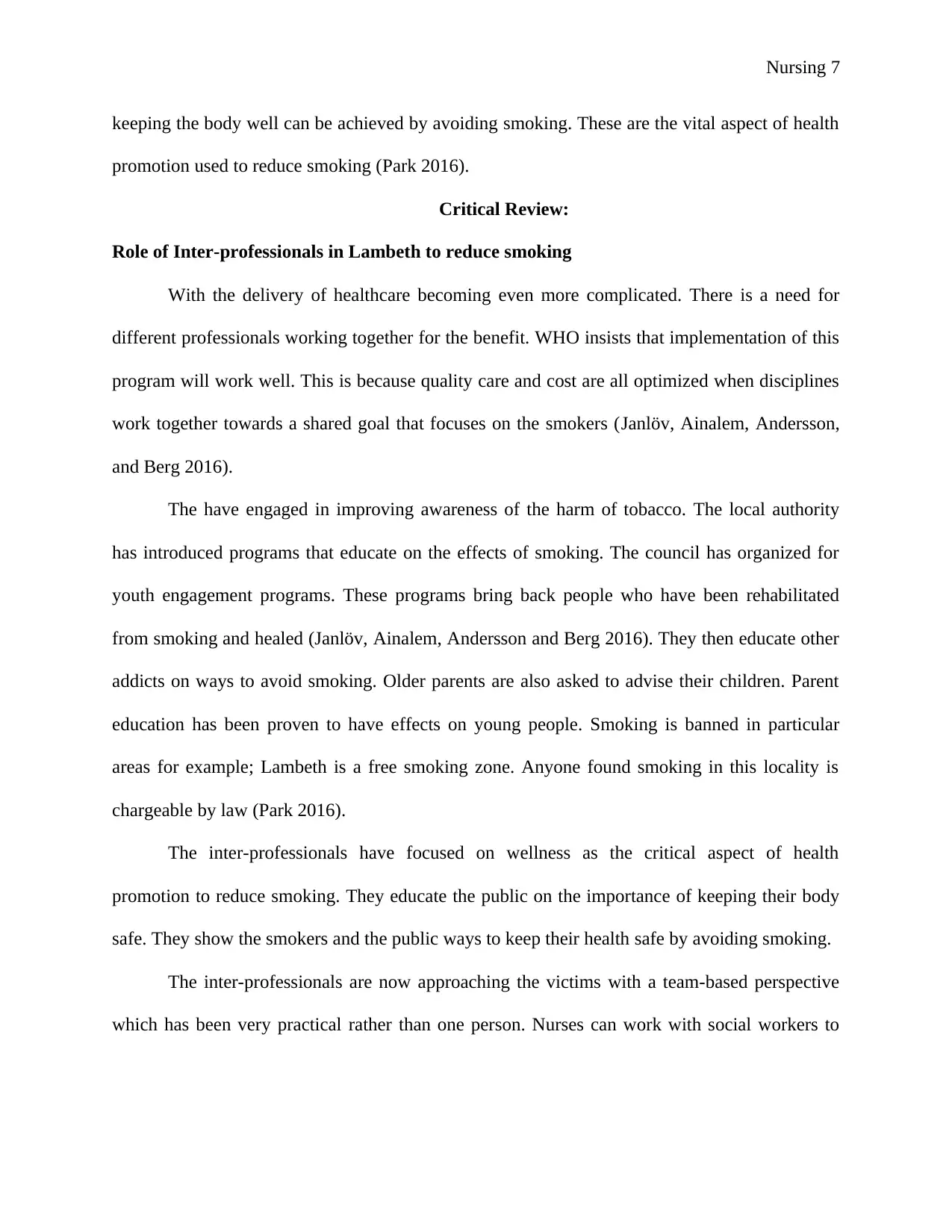
Nursing 7
keeping the body well can be achieved by avoiding smoking. These are the vital aspect of health
promotion used to reduce smoking (Park 2016).
Critical Review:
Role of Inter-professionals in Lambeth to reduce smoking
With the delivery of healthcare becoming even more complicated. There is a need for
different professionals working together for the benefit. WHO insists that implementation of this
program will work well. This is because quality care and cost are all optimized when disciplines
work together towards a shared goal that focuses on the smokers (Janlöv, Ainalem, Andersson,
and Berg 2016).
The have engaged in improving awareness of the harm of tobacco. The local authority
has introduced programs that educate on the effects of smoking. The council has organized for
youth engagement programs. These programs bring back people who have been rehabilitated
from smoking and healed (Janlöv, Ainalem, Andersson and Berg 2016). They then educate other
addicts on ways to avoid smoking. Older parents are also asked to advise their children. Parent
education has been proven to have effects on young people. Smoking is banned in particular
areas for example; Lambeth is a free smoking zone. Anyone found smoking in this locality is
chargeable by law (Park 2016).
The inter-professionals have focused on wellness as the critical aspect of health
promotion to reduce smoking. They educate the public on the importance of keeping their body
safe. They show the smokers and the public ways to keep their health safe by avoiding smoking.
The inter-professionals are now approaching the victims with a team-based perspective
which has been very practical rather than one person. Nurses can work with social workers to
keeping the body well can be achieved by avoiding smoking. These are the vital aspect of health
promotion used to reduce smoking (Park 2016).
Critical Review:
Role of Inter-professionals in Lambeth to reduce smoking
With the delivery of healthcare becoming even more complicated. There is a need for
different professionals working together for the benefit. WHO insists that implementation of this
program will work well. This is because quality care and cost are all optimized when disciplines
work together towards a shared goal that focuses on the smokers (Janlöv, Ainalem, Andersson,
and Berg 2016).
The have engaged in improving awareness of the harm of tobacco. The local authority
has introduced programs that educate on the effects of smoking. The council has organized for
youth engagement programs. These programs bring back people who have been rehabilitated
from smoking and healed (Janlöv, Ainalem, Andersson and Berg 2016). They then educate other
addicts on ways to avoid smoking. Older parents are also asked to advise their children. Parent
education has been proven to have effects on young people. Smoking is banned in particular
areas for example; Lambeth is a free smoking zone. Anyone found smoking in this locality is
chargeable by law (Park 2016).
The inter-professionals have focused on wellness as the critical aspect of health
promotion to reduce smoking. They educate the public on the importance of keeping their body
safe. They show the smokers and the public ways to keep their health safe by avoiding smoking.
The inter-professionals are now approaching the victims with a team-based perspective
which has been very practical rather than one person. Nurses can work with social workers to
Paraphrase This Document
Need a fresh take? Get an instant paraphrase of this document with our AI Paraphraser
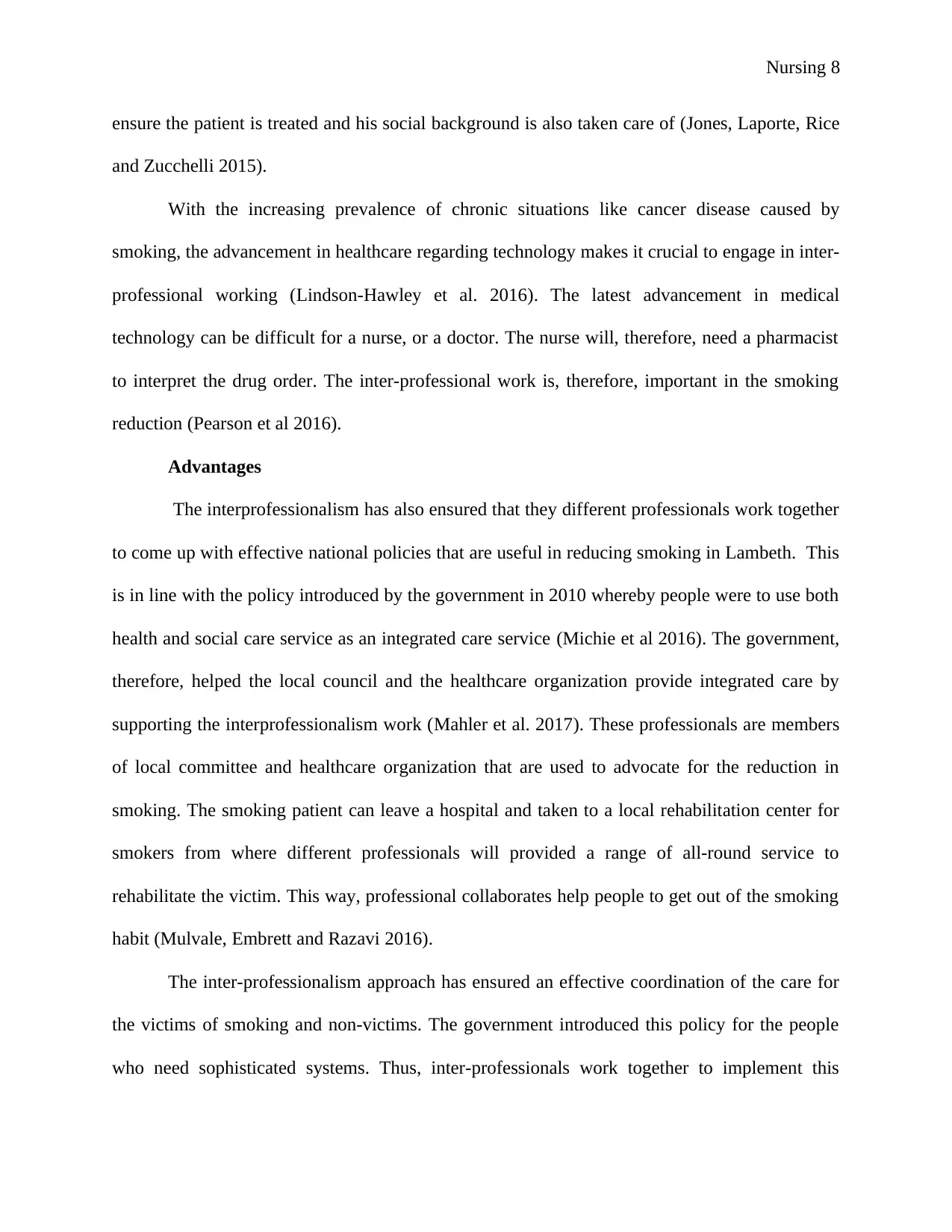
Nursing 8
ensure the patient is treated and his social background is also taken care of (Jones, Laporte, Rice
and Zucchelli 2015).
With the increasing prevalence of chronic situations like cancer disease caused by
smoking, the advancement in healthcare regarding technology makes it crucial to engage in inter-
professional working (Lindson-Hawley et al. 2016). The latest advancement in medical
technology can be difficult for a nurse, or a doctor. The nurse will, therefore, need a pharmacist
to interpret the drug order. The inter-professional work is, therefore, important in the smoking
reduction (Pearson et al 2016).
Advantages
The interprofessionalism has also ensured that they different professionals work together
to come up with effective national policies that are useful in reducing smoking in Lambeth. This
is in line with the policy introduced by the government in 2010 whereby people were to use both
health and social care service as an integrated care service (Michie et al 2016). The government,
therefore, helped the local council and the healthcare organization provide integrated care by
supporting the interprofessionalism work (Mahler et al. 2017). These professionals are members
of local committee and healthcare organization that are used to advocate for the reduction in
smoking. The smoking patient can leave a hospital and taken to a local rehabilitation center for
smokers from where different professionals will provided a range of all-round service to
rehabilitate the victim. This way, professional collaborates help people to get out of the smoking
habit (Mulvale, Embrett and Razavi 2016).
The inter-professionalism approach has ensured an effective coordination of the care for
the victims of smoking and non-victims. The government introduced this policy for the people
who need sophisticated systems. Thus, inter-professionals work together to implement this
ensure the patient is treated and his social background is also taken care of (Jones, Laporte, Rice
and Zucchelli 2015).
With the increasing prevalence of chronic situations like cancer disease caused by
smoking, the advancement in healthcare regarding technology makes it crucial to engage in inter-
professional working (Lindson-Hawley et al. 2016). The latest advancement in medical
technology can be difficult for a nurse, or a doctor. The nurse will, therefore, need a pharmacist
to interpret the drug order. The inter-professional work is, therefore, important in the smoking
reduction (Pearson et al 2016).
Advantages
The interprofessionalism has also ensured that they different professionals work together
to come up with effective national policies that are useful in reducing smoking in Lambeth. This
is in line with the policy introduced by the government in 2010 whereby people were to use both
health and social care service as an integrated care service (Michie et al 2016). The government,
therefore, helped the local council and the healthcare organization provide integrated care by
supporting the interprofessionalism work (Mahler et al. 2017). These professionals are members
of local committee and healthcare organization that are used to advocate for the reduction in
smoking. The smoking patient can leave a hospital and taken to a local rehabilitation center for
smokers from where different professionals will provided a range of all-round service to
rehabilitate the victim. This way, professional collaborates help people to get out of the smoking
habit (Mulvale, Embrett and Razavi 2016).
The inter-professionalism approach has ensured an effective coordination of the care for
the victims of smoking and non-victims. The government introduced this policy for the people
who need sophisticated systems. Thus, inter-professionals work together to implement this
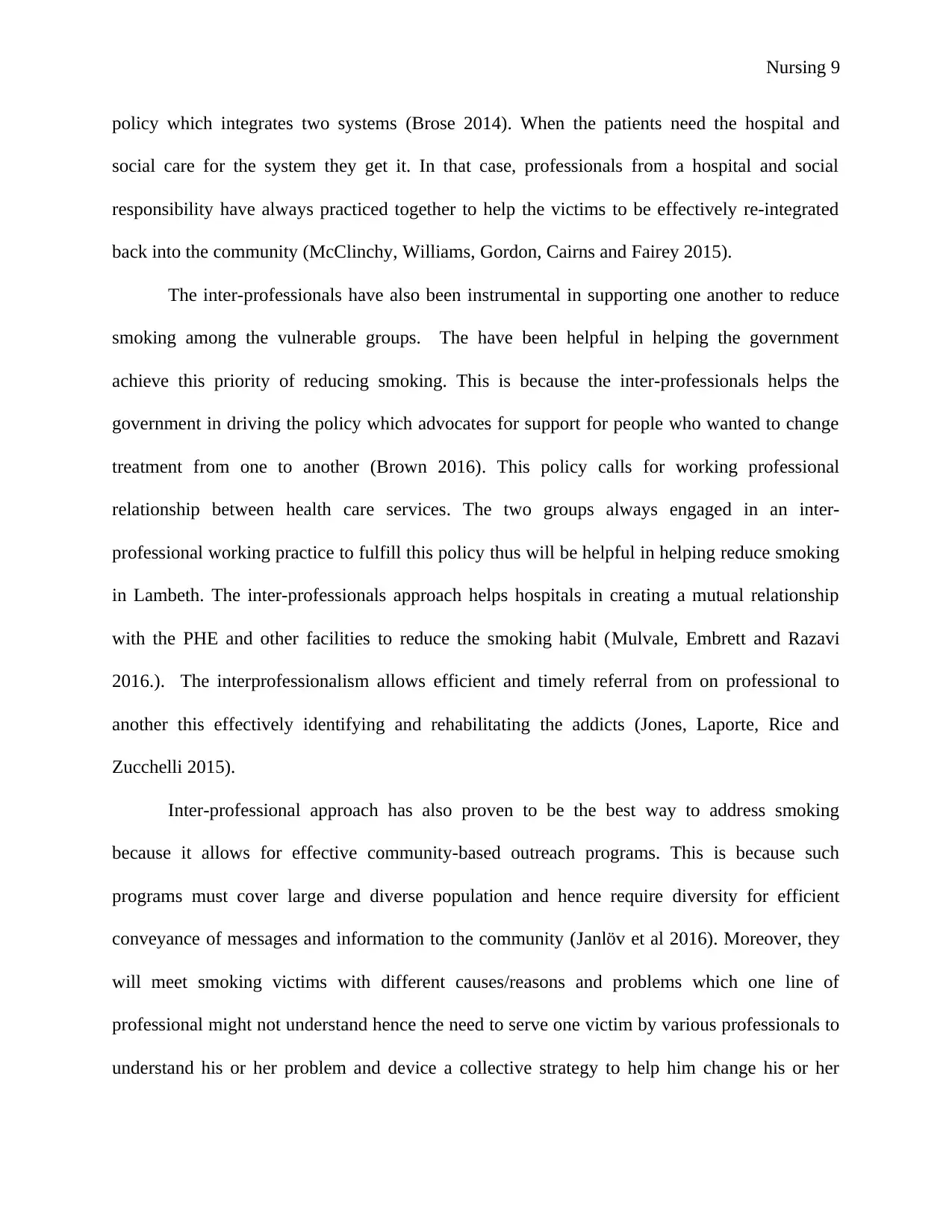
Nursing 9
policy which integrates two systems (Brose 2014). When the patients need the hospital and
social care for the system they get it. In that case, professionals from a hospital and social
responsibility have always practiced together to help the victims to be effectively re-integrated
back into the community (McClinchy, Williams, Gordon, Cairns and Fairey 2015).
The inter-professionals have also been instrumental in supporting one another to reduce
smoking among the vulnerable groups. The have been helpful in helping the government
achieve this priority of reducing smoking. This is because the inter-professionals helps the
government in driving the policy which advocates for support for people who wanted to change
treatment from one to another (Brown 2016). This policy calls for working professional
relationship between health care services. The two groups always engaged in an inter-
professional working practice to fulfill this policy thus will be helpful in helping reduce smoking
in Lambeth. The inter-professionals approach helps hospitals in creating a mutual relationship
with the PHE and other facilities to reduce the smoking habit (Mulvale, Embrett and Razavi
2016.). The interprofessionalism allows efficient and timely referral from on professional to
another this effectively identifying and rehabilitating the addicts (Jones, Laporte, Rice and
Zucchelli 2015).
Inter-professional approach has also proven to be the best way to address smoking
because it allows for effective community-based outreach programs. This is because such
programs must cover large and diverse population and hence require diversity for efficient
conveyance of messages and information to the community (Janlöv et al 2016). Moreover, they
will meet smoking victims with different causes/reasons and problems which one line of
professional might not understand hence the need to serve one victim by various professionals to
understand his or her problem and device a collective strategy to help him change his or her
policy which integrates two systems (Brose 2014). When the patients need the hospital and
social care for the system they get it. In that case, professionals from a hospital and social
responsibility have always practiced together to help the victims to be effectively re-integrated
back into the community (McClinchy, Williams, Gordon, Cairns and Fairey 2015).
The inter-professionals have also been instrumental in supporting one another to reduce
smoking among the vulnerable groups. The have been helpful in helping the government
achieve this priority of reducing smoking. This is because the inter-professionals helps the
government in driving the policy which advocates for support for people who wanted to change
treatment from one to another (Brown 2016). This policy calls for working professional
relationship between health care services. The two groups always engaged in an inter-
professional working practice to fulfill this policy thus will be helpful in helping reduce smoking
in Lambeth. The inter-professionals approach helps hospitals in creating a mutual relationship
with the PHE and other facilities to reduce the smoking habit (Mulvale, Embrett and Razavi
2016.). The interprofessionalism allows efficient and timely referral from on professional to
another this effectively identifying and rehabilitating the addicts (Jones, Laporte, Rice and
Zucchelli 2015).
Inter-professional approach has also proven to be the best way to address smoking
because it allows for effective community-based outreach programs. This is because such
programs must cover large and diverse population and hence require diversity for efficient
conveyance of messages and information to the community (Janlöv et al 2016). Moreover, they
will meet smoking victims with different causes/reasons and problems which one line of
professional might not understand hence the need to serve one victim by various professionals to
understand his or her problem and device a collective strategy to help him change his or her
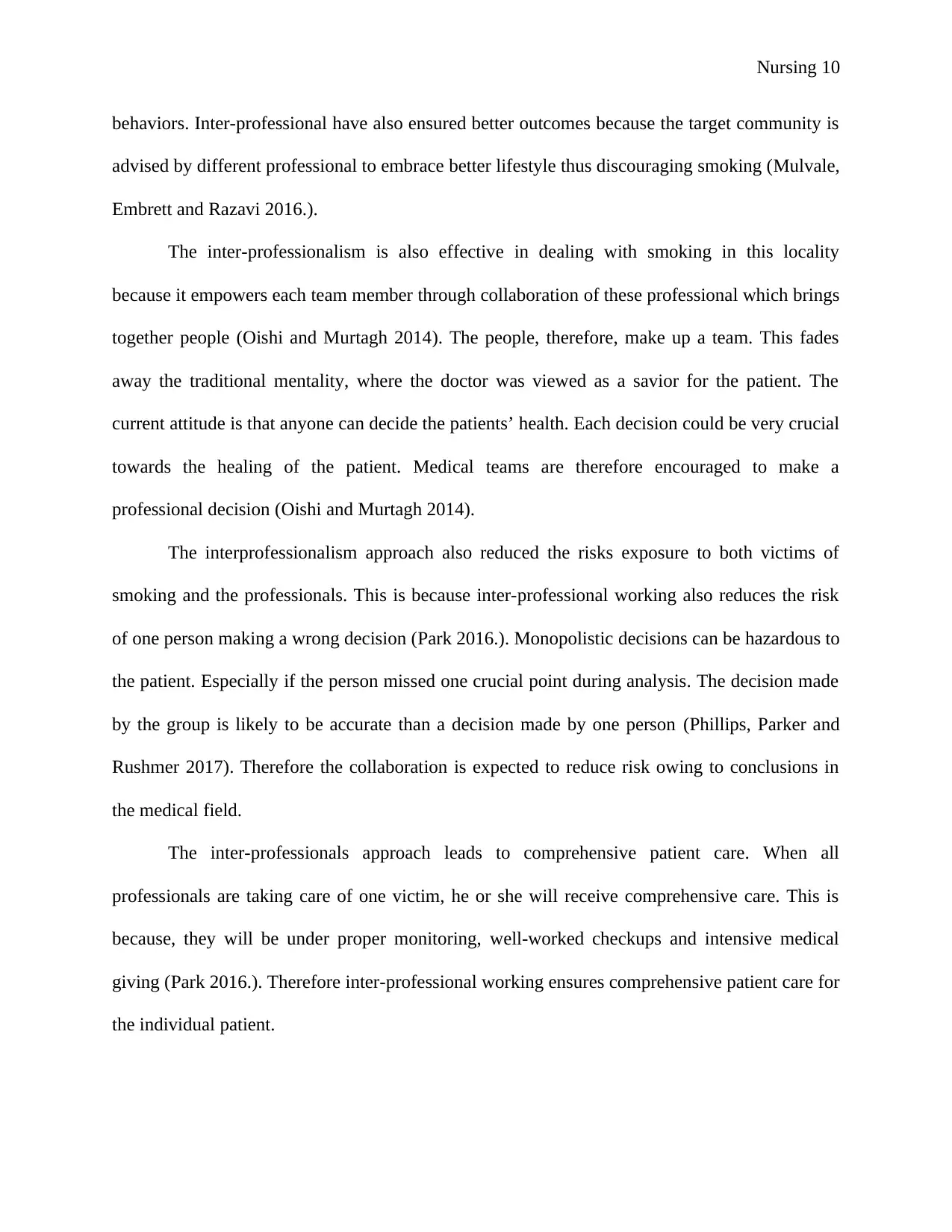
Nursing 10
behaviors. Inter-professional have also ensured better outcomes because the target community is
advised by different professional to embrace better lifestyle thus discouraging smoking (Mulvale,
Embrett and Razavi 2016.).
The inter-professionalism is also effective in dealing with smoking in this locality
because it empowers each team member through collaboration of these professional which brings
together people (Oishi and Murtagh 2014). The people, therefore, make up a team. This fades
away the traditional mentality, where the doctor was viewed as a savior for the patient. The
current attitude is that anyone can decide the patients’ health. Each decision could be very crucial
towards the healing of the patient. Medical teams are therefore encouraged to make a
professional decision (Oishi and Murtagh 2014).
The interprofessionalism approach also reduced the risks exposure to both victims of
smoking and the professionals. This is because inter-professional working also reduces the risk
of one person making a wrong decision (Park 2016.). Monopolistic decisions can be hazardous to
the patient. Especially if the person missed one crucial point during analysis. The decision made
by the group is likely to be accurate than a decision made by one person (Phillips, Parker and
Rushmer 2017). Therefore the collaboration is expected to reduce risk owing to conclusions in
the medical field.
The inter-professionals approach leads to comprehensive patient care. When all
professionals are taking care of one victim, he or she will receive comprehensive care. This is
because, they will be under proper monitoring, well-worked checkups and intensive medical
giving (Park 2016.). Therefore inter-professional working ensures comprehensive patient care for
the individual patient.
behaviors. Inter-professional have also ensured better outcomes because the target community is
advised by different professional to embrace better lifestyle thus discouraging smoking (Mulvale,
Embrett and Razavi 2016.).
The inter-professionalism is also effective in dealing with smoking in this locality
because it empowers each team member through collaboration of these professional which brings
together people (Oishi and Murtagh 2014). The people, therefore, make up a team. This fades
away the traditional mentality, where the doctor was viewed as a savior for the patient. The
current attitude is that anyone can decide the patients’ health. Each decision could be very crucial
towards the healing of the patient. Medical teams are therefore encouraged to make a
professional decision (Oishi and Murtagh 2014).
The interprofessionalism approach also reduced the risks exposure to both victims of
smoking and the professionals. This is because inter-professional working also reduces the risk
of one person making a wrong decision (Park 2016.). Monopolistic decisions can be hazardous to
the patient. Especially if the person missed one crucial point during analysis. The decision made
by the group is likely to be accurate than a decision made by one person (Phillips, Parker and
Rushmer 2017). Therefore the collaboration is expected to reduce risk owing to conclusions in
the medical field.
The inter-professionals approach leads to comprehensive patient care. When all
professionals are taking care of one victim, he or she will receive comprehensive care. This is
because, they will be under proper monitoring, well-worked checkups and intensive medical
giving (Park 2016.). Therefore inter-professional working ensures comprehensive patient care for
the individual patient.
Secure Best Marks with AI Grader
Need help grading? Try our AI Grader for instant feedback on your assignments.

Nursing 11
According to the book, an innovative approach to specialized surgical care. Dr. Lindeson
argues that individual medical decision are desperate to make. This comes when meeting a case
that the medic has never met before. Or a situation that one has never diagnosed previously. Such
situation puts the pressure on the practitioner as they try to come up with a decision (Reeves,
Xyrichis and Zwarenstein 2018). That is not the case when there is inter-professional
consultation. The professionals will generate ideas together, therefore, reducing stress on the
individual. This, thus, shows how inter-professional working reduces personal pressure.
Disadvantages
Inactive collaboration: According to nursing times, a journal done by Jenni Middleton.
The inter-professional job requires frequent consultation for proper decision making. In case one
of the professionals prefer the formal ways of communication, it shall have derailed the team
(McClinchy et al 2017). Drafting a letter to another professional while there is an emergency
case might lead to fatal endings. Therefore this method is only possible with an eye to eye
consultations.
Variation of philosophy: According to nursing times, a journal done by Jenni Middleton.
Different professional groups are trained using different viewpoints (Janlöv, Ainalem, Andersson
and Berg 2016). These philosophies fit each of the groups. The high moral theories include;
cure-oriented medic, public health, and social advocate. When these philosophies crush during
the consultation, a patient might take long before being attended to as the two or more parties are
still consulting. If it were one person, the consultation time is reduced as much time is used in
handling the patient (Frazer et al 2016). The method, therefore, puts a patient who is in an
emergency, under the danger of losing their lives.
According to the book, an innovative approach to specialized surgical care. Dr. Lindeson
argues that individual medical decision are desperate to make. This comes when meeting a case
that the medic has never met before. Or a situation that one has never diagnosed previously. Such
situation puts the pressure on the practitioner as they try to come up with a decision (Reeves,
Xyrichis and Zwarenstein 2018). That is not the case when there is inter-professional
consultation. The professionals will generate ideas together, therefore, reducing stress on the
individual. This, thus, shows how inter-professional working reduces personal pressure.
Disadvantages
Inactive collaboration: According to nursing times, a journal done by Jenni Middleton.
The inter-professional job requires frequent consultation for proper decision making. In case one
of the professionals prefer the formal ways of communication, it shall have derailed the team
(McClinchy et al 2017). Drafting a letter to another professional while there is an emergency
case might lead to fatal endings. Therefore this method is only possible with an eye to eye
consultations.
Variation of philosophy: According to nursing times, a journal done by Jenni Middleton.
Different professional groups are trained using different viewpoints (Janlöv, Ainalem, Andersson
and Berg 2016). These philosophies fit each of the groups. The high moral theories include;
cure-oriented medic, public health, and social advocate. When these philosophies crush during
the consultation, a patient might take long before being attended to as the two or more parties are
still consulting. If it were one person, the consultation time is reduced as much time is used in
handling the patient (Frazer et al 2016). The method, therefore, puts a patient who is in an
emergency, under the danger of losing their lives.
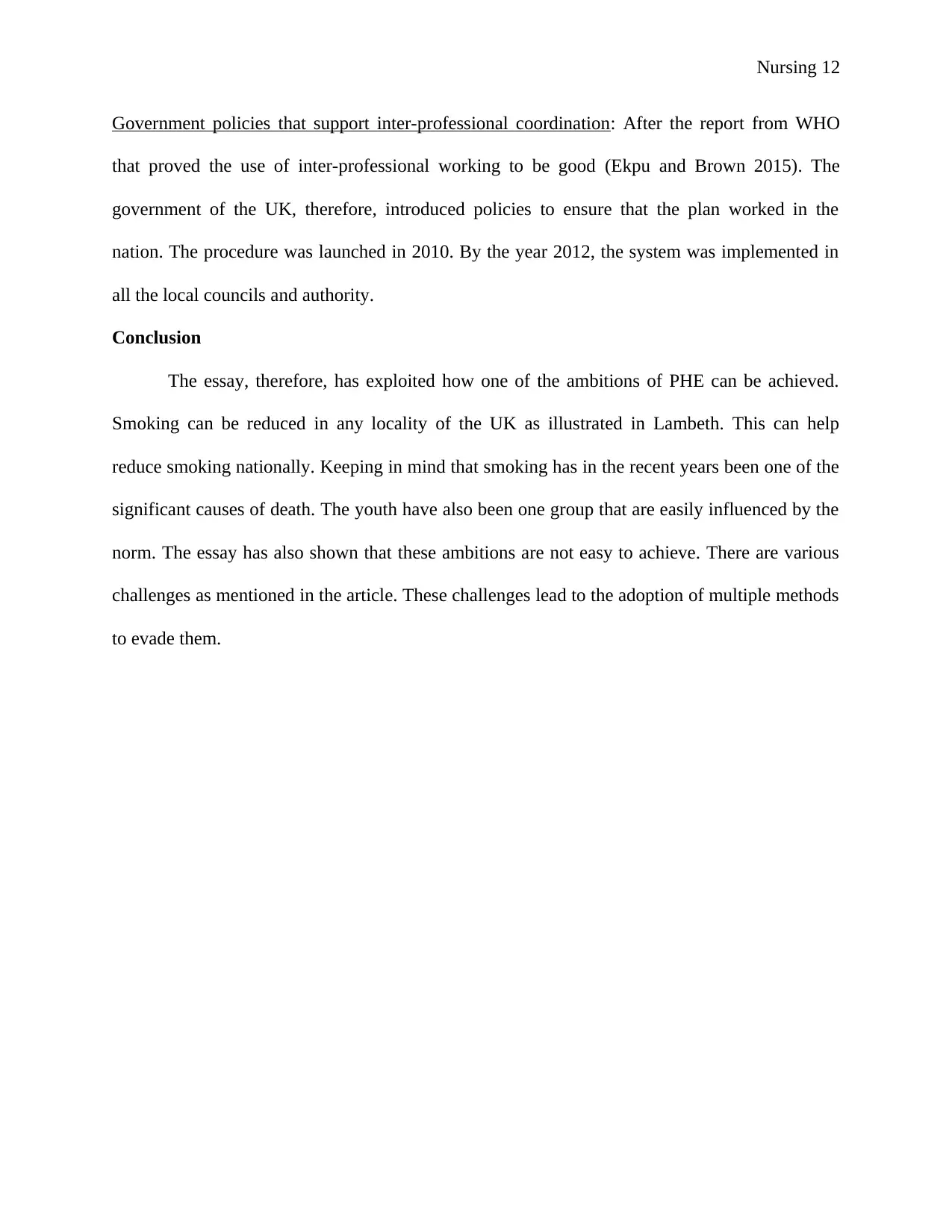
Nursing 12
Government policies that support inter-professional coordination: After the report from WHO
that proved the use of inter-professional working to be good (Ekpu and Brown 2015). The
government of the UK, therefore, introduced policies to ensure that the plan worked in the
nation. The procedure was launched in 2010. By the year 2012, the system was implemented in
all the local councils and authority.
Conclusion
The essay, therefore, has exploited how one of the ambitions of PHE can be achieved.
Smoking can be reduced in any locality of the UK as illustrated in Lambeth. This can help
reduce smoking nationally. Keeping in mind that smoking has in the recent years been one of the
significant causes of death. The youth have also been one group that are easily influenced by the
norm. The essay has also shown that these ambitions are not easy to achieve. There are various
challenges as mentioned in the article. These challenges lead to the adoption of multiple methods
to evade them.
Government policies that support inter-professional coordination: After the report from WHO
that proved the use of inter-professional working to be good (Ekpu and Brown 2015). The
government of the UK, therefore, introduced policies to ensure that the plan worked in the
nation. The procedure was launched in 2010. By the year 2012, the system was implemented in
all the local councils and authority.
Conclusion
The essay, therefore, has exploited how one of the ambitions of PHE can be achieved.
Smoking can be reduced in any locality of the UK as illustrated in Lambeth. This can help
reduce smoking nationally. Keeping in mind that smoking has in the recent years been one of the
significant causes of death. The youth have also been one group that are easily influenced by the
norm. The essay has also shown that these ambitions are not easy to achieve. There are various
challenges as mentioned in the article. These challenges lead to the adoption of multiple methods
to evade them.
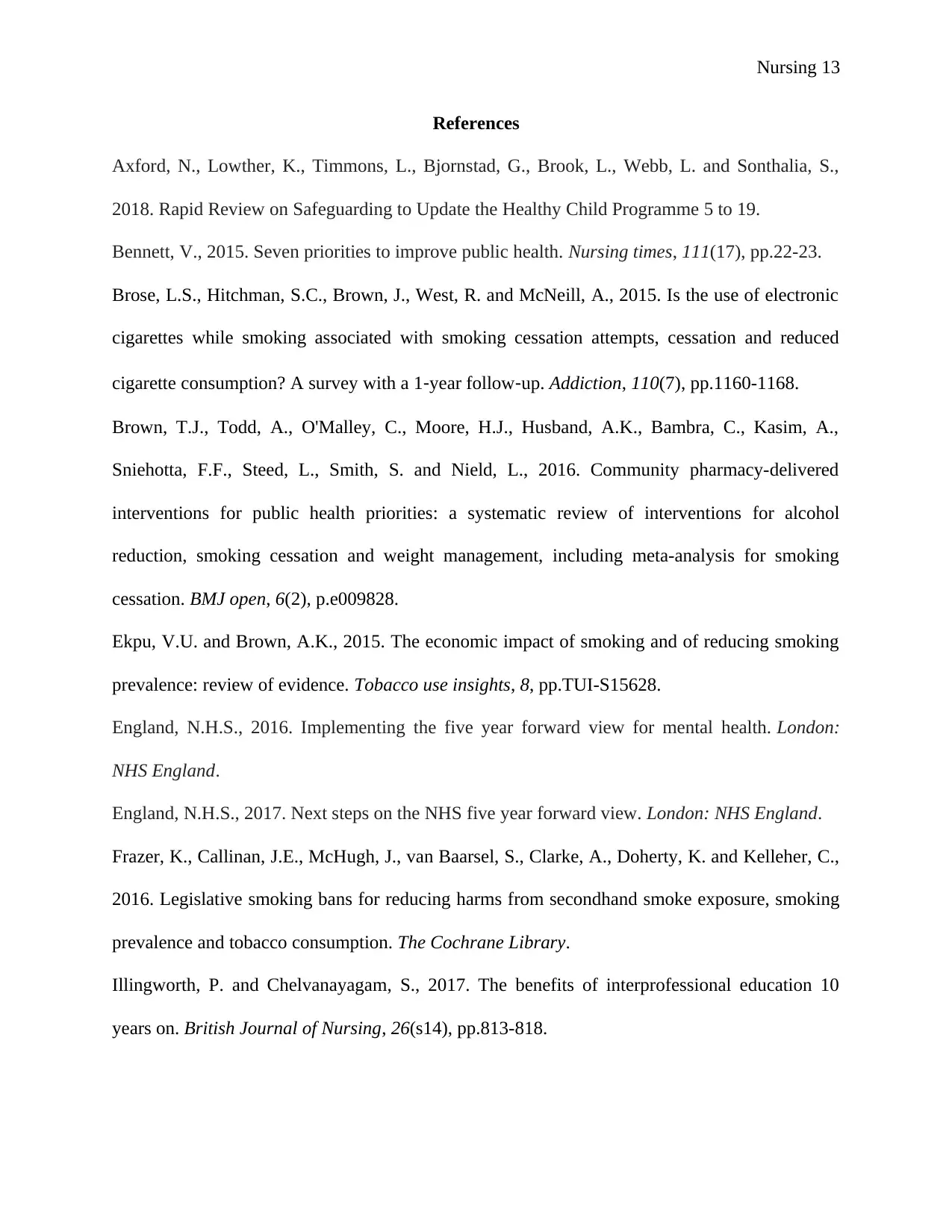
Nursing 13
References
Axford, N., Lowther, K., Timmons, L., Bjornstad, G., Brook, L., Webb, L. and Sonthalia, S.,
2018. Rapid Review on Safeguarding to Update the Healthy Child Programme 5 to 19.
Bennett, V., 2015. Seven priorities to improve public health. Nursing times, 111(17), pp.22-23.
Brose, L.S., Hitchman, S.C., Brown, J., West, R. and McNeill, A., 2015. Is the use of electronic
cigarettes while smoking associated with smoking cessation attempts, cessation and reduced
cigarette consumption? A survey with a 1‐year follow‐up. Addiction, 110(7), pp.1160-1168.
Brown, T.J., Todd, A., O'Malley, C., Moore, H.J., Husband, A.K., Bambra, C., Kasim, A.,
Sniehotta, F.F., Steed, L., Smith, S. and Nield, L., 2016. Community pharmacy-delivered
interventions for public health priorities: a systematic review of interventions for alcohol
reduction, smoking cessation and weight management, including meta-analysis for smoking
cessation. BMJ open, 6(2), p.e009828.
Ekpu, V.U. and Brown, A.K., 2015. The economic impact of smoking and of reducing smoking
prevalence: review of evidence. Tobacco use insights, 8, pp.TUI-S15628.
England, N.H.S., 2016. Implementing the five year forward view for mental health. London:
NHS England.
England, N.H.S., 2017. Next steps on the NHS five year forward view. London: NHS England.
Frazer, K., Callinan, J.E., McHugh, J., van Baarsel, S., Clarke, A., Doherty, K. and Kelleher, C.,
2016. Legislative smoking bans for reducing harms from secondhand smoke exposure, smoking
prevalence and tobacco consumption. The Cochrane Library.
Illingworth, P. and Chelvanayagam, S., 2017. The benefits of interprofessional education 10
years on. British Journal of Nursing, 26(s14), pp.813-818.
References
Axford, N., Lowther, K., Timmons, L., Bjornstad, G., Brook, L., Webb, L. and Sonthalia, S.,
2018. Rapid Review on Safeguarding to Update the Healthy Child Programme 5 to 19.
Bennett, V., 2015. Seven priorities to improve public health. Nursing times, 111(17), pp.22-23.
Brose, L.S., Hitchman, S.C., Brown, J., West, R. and McNeill, A., 2015. Is the use of electronic
cigarettes while smoking associated with smoking cessation attempts, cessation and reduced
cigarette consumption? A survey with a 1‐year follow‐up. Addiction, 110(7), pp.1160-1168.
Brown, T.J., Todd, A., O'Malley, C., Moore, H.J., Husband, A.K., Bambra, C., Kasim, A.,
Sniehotta, F.F., Steed, L., Smith, S. and Nield, L., 2016. Community pharmacy-delivered
interventions for public health priorities: a systematic review of interventions for alcohol
reduction, smoking cessation and weight management, including meta-analysis for smoking
cessation. BMJ open, 6(2), p.e009828.
Ekpu, V.U. and Brown, A.K., 2015. The economic impact of smoking and of reducing smoking
prevalence: review of evidence. Tobacco use insights, 8, pp.TUI-S15628.
England, N.H.S., 2016. Implementing the five year forward view for mental health. London:
NHS England.
England, N.H.S., 2017. Next steps on the NHS five year forward view. London: NHS England.
Frazer, K., Callinan, J.E., McHugh, J., van Baarsel, S., Clarke, A., Doherty, K. and Kelleher, C.,
2016. Legislative smoking bans for reducing harms from secondhand smoke exposure, smoking
prevalence and tobacco consumption. The Cochrane Library.
Illingworth, P. and Chelvanayagam, S., 2017. The benefits of interprofessional education 10
years on. British Journal of Nursing, 26(s14), pp.813-818.
Paraphrase This Document
Need a fresh take? Get an instant paraphrase of this document with our AI Paraphraser
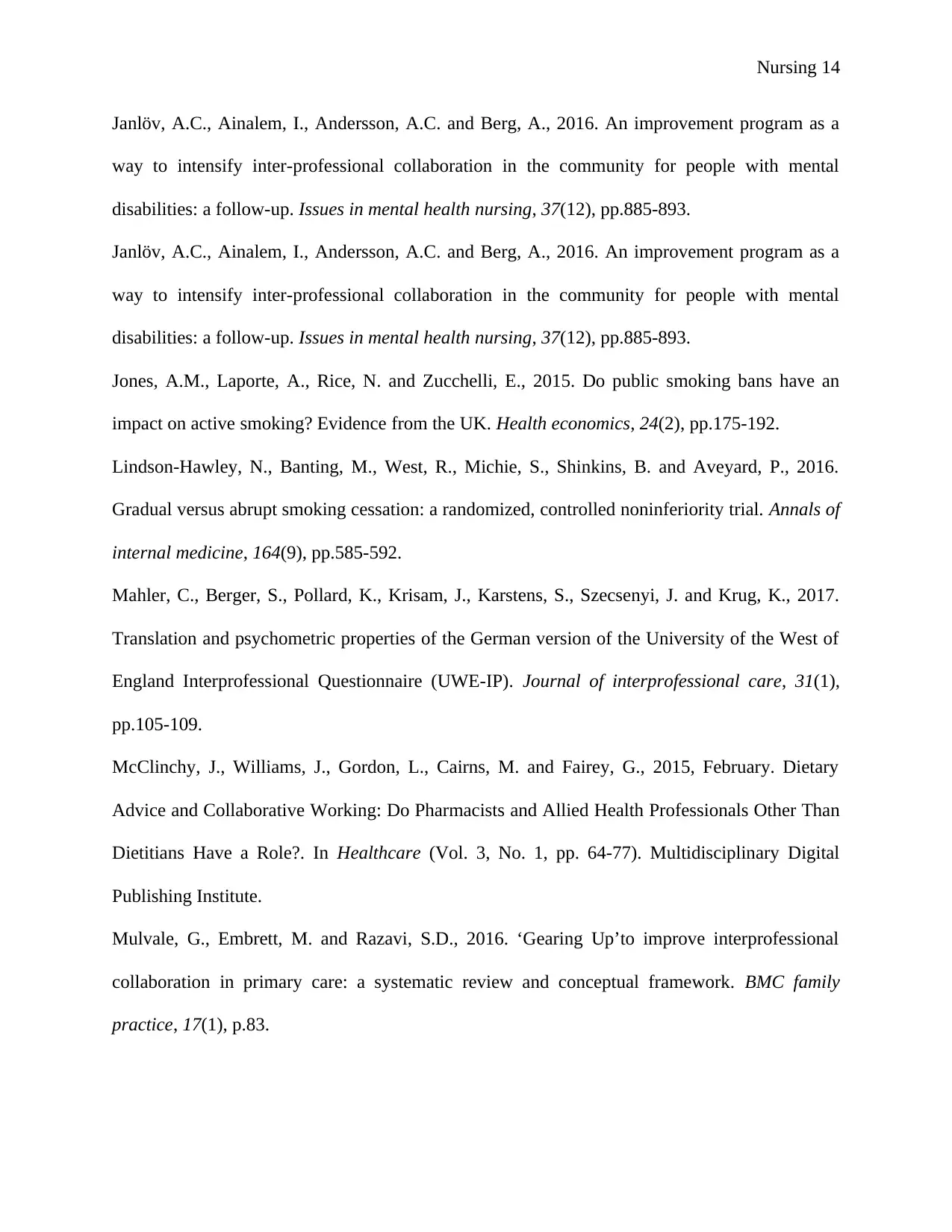
Nursing 14
Janlöv, A.C., Ainalem, I., Andersson, A.C. and Berg, A., 2016. An improvement program as a
way to intensify inter-professional collaboration in the community for people with mental
disabilities: a follow-up. Issues in mental health nursing, 37(12), pp.885-893.
Janlöv, A.C., Ainalem, I., Andersson, A.C. and Berg, A., 2016. An improvement program as a
way to intensify inter-professional collaboration in the community for people with mental
disabilities: a follow-up. Issues in mental health nursing, 37(12), pp.885-893.
Jones, A.M., Laporte, A., Rice, N. and Zucchelli, E., 2015. Do public smoking bans have an
impact on active smoking? Evidence from the UK. Health economics, 24(2), pp.175-192.
Lindson-Hawley, N., Banting, M., West, R., Michie, S., Shinkins, B. and Aveyard, P., 2016.
Gradual versus abrupt smoking cessation: a randomized, controlled noninferiority trial. Annals of
internal medicine, 164(9), pp.585-592.
Mahler, C., Berger, S., Pollard, K., Krisam, J., Karstens, S., Szecsenyi, J. and Krug, K., 2017.
Translation and psychometric properties of the German version of the University of the West of
England Interprofessional Questionnaire (UWE-IP). Journal of interprofessional care, 31(1),
pp.105-109.
McClinchy, J., Williams, J., Gordon, L., Cairns, M. and Fairey, G., 2015, February. Dietary
Advice and Collaborative Working: Do Pharmacists and Allied Health Professionals Other Than
Dietitians Have a Role?. In Healthcare (Vol. 3, No. 1, pp. 64-77). Multidisciplinary Digital
Publishing Institute.
Mulvale, G., Embrett, M. and Razavi, S.D., 2016. ‘Gearing Up’to improve interprofessional
collaboration in primary care: a systematic review and conceptual framework. BMC family
practice, 17(1), p.83.
Janlöv, A.C., Ainalem, I., Andersson, A.C. and Berg, A., 2016. An improvement program as a
way to intensify inter-professional collaboration in the community for people with mental
disabilities: a follow-up. Issues in mental health nursing, 37(12), pp.885-893.
Janlöv, A.C., Ainalem, I., Andersson, A.C. and Berg, A., 2016. An improvement program as a
way to intensify inter-professional collaboration in the community for people with mental
disabilities: a follow-up. Issues in mental health nursing, 37(12), pp.885-893.
Jones, A.M., Laporte, A., Rice, N. and Zucchelli, E., 2015. Do public smoking bans have an
impact on active smoking? Evidence from the UK. Health economics, 24(2), pp.175-192.
Lindson-Hawley, N., Banting, M., West, R., Michie, S., Shinkins, B. and Aveyard, P., 2016.
Gradual versus abrupt smoking cessation: a randomized, controlled noninferiority trial. Annals of
internal medicine, 164(9), pp.585-592.
Mahler, C., Berger, S., Pollard, K., Krisam, J., Karstens, S., Szecsenyi, J. and Krug, K., 2017.
Translation and psychometric properties of the German version of the University of the West of
England Interprofessional Questionnaire (UWE-IP). Journal of interprofessional care, 31(1),
pp.105-109.
McClinchy, J., Williams, J., Gordon, L., Cairns, M. and Fairey, G., 2015, February. Dietary
Advice and Collaborative Working: Do Pharmacists and Allied Health Professionals Other Than
Dietitians Have a Role?. In Healthcare (Vol. 3, No. 1, pp. 64-77). Multidisciplinary Digital
Publishing Institute.
Mulvale, G., Embrett, M. and Razavi, S.D., 2016. ‘Gearing Up’to improve interprofessional
collaboration in primary care: a systematic review and conceptual framework. BMC family
practice, 17(1), p.83.
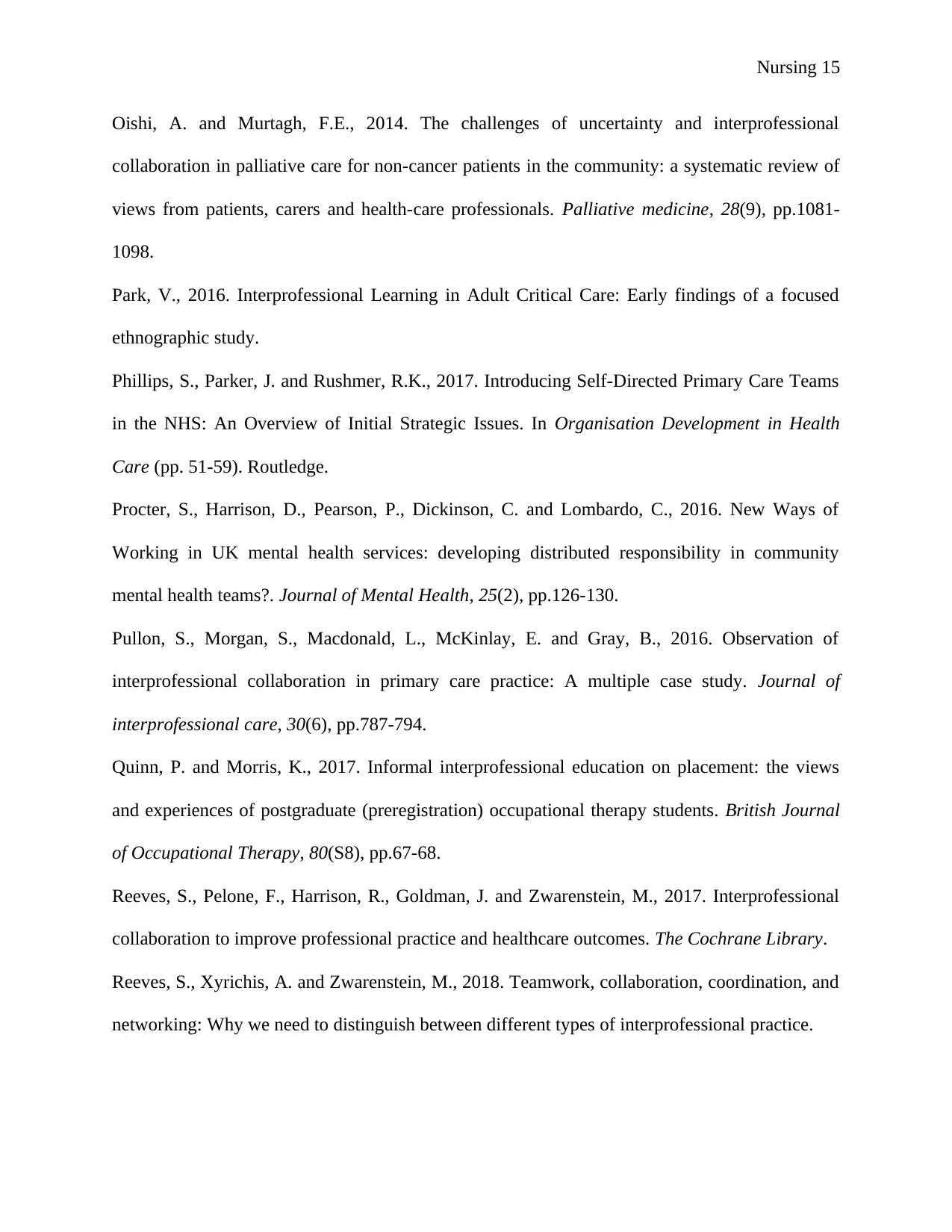
Nursing 15
Oishi, A. and Murtagh, F.E., 2014. The challenges of uncertainty and interprofessional
collaboration in palliative care for non-cancer patients in the community: a systematic review of
views from patients, carers and health-care professionals. Palliative medicine, 28(9), pp.1081-
1098.
Park, V., 2016. Interprofessional Learning in Adult Critical Care: Early findings of a focused
ethnographic study.
Phillips, S., Parker, J. and Rushmer, R.K., 2017. Introducing Self-Directed Primary Care Teams
in the NHS: An Overview of Initial Strategic Issues. In Organisation Development in Health
Care (pp. 51-59). Routledge.
Procter, S., Harrison, D., Pearson, P., Dickinson, C. and Lombardo, C., 2016. New Ways of
Working in UK mental health services: developing distributed responsibility in community
mental health teams?. Journal of Mental Health, 25(2), pp.126-130.
Pullon, S., Morgan, S., Macdonald, L., McKinlay, E. and Gray, B., 2016. Observation of
interprofessional collaboration in primary care practice: A multiple case study. Journal of
interprofessional care, 30(6), pp.787-794.
Quinn, P. and Morris, K., 2017. Informal interprofessional education on placement: the views
and experiences of postgraduate (preregistration) occupational therapy students. British Journal
of Occupational Therapy, 80(S8), pp.67-68.
Reeves, S., Pelone, F., Harrison, R., Goldman, J. and Zwarenstein, M., 2017. Interprofessional
collaboration to improve professional practice and healthcare outcomes. The Cochrane Library.
Reeves, S., Xyrichis, A. and Zwarenstein, M., 2018. Teamwork, collaboration, coordination, and
networking: Why we need to distinguish between different types of interprofessional practice.
Oishi, A. and Murtagh, F.E., 2014. The challenges of uncertainty and interprofessional
collaboration in palliative care for non-cancer patients in the community: a systematic review of
views from patients, carers and health-care professionals. Palliative medicine, 28(9), pp.1081-
1098.
Park, V., 2016. Interprofessional Learning in Adult Critical Care: Early findings of a focused
ethnographic study.
Phillips, S., Parker, J. and Rushmer, R.K., 2017. Introducing Self-Directed Primary Care Teams
in the NHS: An Overview of Initial Strategic Issues. In Organisation Development in Health
Care (pp. 51-59). Routledge.
Procter, S., Harrison, D., Pearson, P., Dickinson, C. and Lombardo, C., 2016. New Ways of
Working in UK mental health services: developing distributed responsibility in community
mental health teams?. Journal of Mental Health, 25(2), pp.126-130.
Pullon, S., Morgan, S., Macdonald, L., McKinlay, E. and Gray, B., 2016. Observation of
interprofessional collaboration in primary care practice: A multiple case study. Journal of
interprofessional care, 30(6), pp.787-794.
Quinn, P. and Morris, K., 2017. Informal interprofessional education on placement: the views
and experiences of postgraduate (preregistration) occupational therapy students. British Journal
of Occupational Therapy, 80(S8), pp.67-68.
Reeves, S., Pelone, F., Harrison, R., Goldman, J. and Zwarenstein, M., 2017. Interprofessional
collaboration to improve professional practice and healthcare outcomes. The Cochrane Library.
Reeves, S., Xyrichis, A. and Zwarenstein, M., 2018. Teamwork, collaboration, coordination, and
networking: Why we need to distinguish between different types of interprofessional practice.
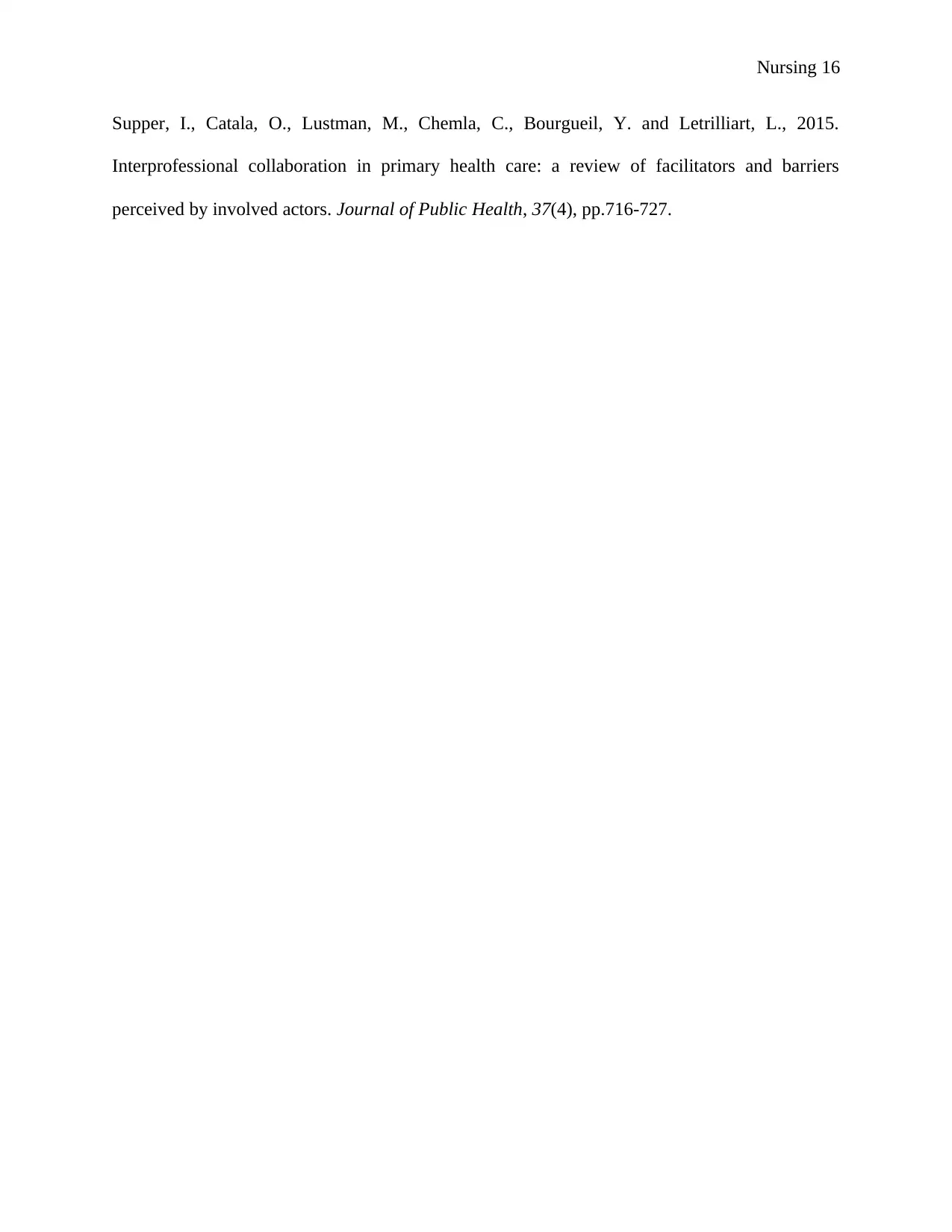
Nursing 16
Supper, I., Catala, O., Lustman, M., Chemla, C., Bourgueil, Y. and Letrilliart, L., 2015.
Interprofessional collaboration in primary health care: a review of facilitators and barriers
perceived by involved actors. Journal of Public Health, 37(4), pp.716-727.
Supper, I., Catala, O., Lustman, M., Chemla, C., Bourgueil, Y. and Letrilliart, L., 2015.
Interprofessional collaboration in primary health care: a review of facilitators and barriers
perceived by involved actors. Journal of Public Health, 37(4), pp.716-727.
1 out of 16
Related Documents
Your All-in-One AI-Powered Toolkit for Academic Success.
+13062052269
info@desklib.com
Available 24*7 on WhatsApp / Email
![[object Object]](/_next/static/media/star-bottom.7253800d.svg)
Unlock your academic potential
© 2024 | Zucol Services PVT LTD | All rights reserved.





